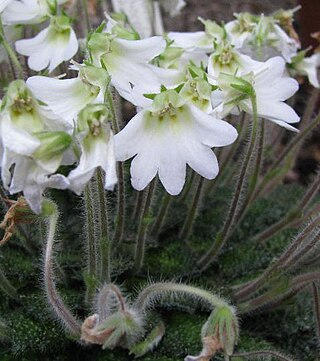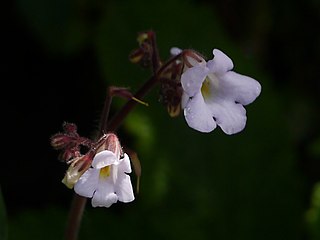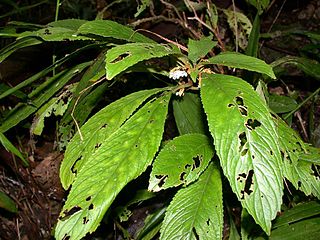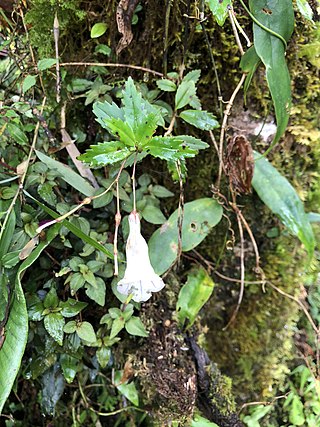
Zingiber is a genus of flowering plants in the family Zingiberaceae. It is native to China, the Indian Subcontinent, New Guinea, and Southeast Asia, especially Thailand. It contains the true gingers, plants grown the world over for their culinary value. The most well known species are Z. officinale and Z. mioga, two garden gingers.

Gesneriaceae, the gesneriad family, is a family of flowering plants consisting of about 152 genera and ca. 3,540 species in the tropics and subtropics of the Old World and the New World, with a very small number extending to temperate areas. Many species have colorful and showy flowers and are cultivated as ornamental plants.

Aeschynanthus is a genus of about 150 species of evergreen subtropical and tropical plants in the family Gesneriaceae. They are usually trailing epiphytes with brightly colored flowers that are pollinated by sunbirds. The genus name comes from a contraction of aischuno and anthos (flower). The common name for some species is lipstick plant, which comes from the appearance of the developing buds emerging from the calyces. A full list of the accepted species and their synonyms can be found in the Smithsonian Institution's World Checklist of Gesneriaceae.

Petrocosmea is a genus of the family Gesneriaceae, the African violet family. Many of the species within this genus are endemic to high-elevation areas in Western China, although some are native to other parts of Asia. including north-central and southern China, Indochina, and the eastern Himalayas. It is a rosette-forming genus that generally grows on wet mossy rocks or forests.

Primulina is a genus of flowering plants in the African violet family Gesneriaceae. It includes 232 species native to southern and north-central China and northern Vietnam. The species are mostly calciphilous, and typically grow in the extensive limestone karst regions of China and Vietnam.

Henckelia is a genus of flowering plants in the family Gesneriaceae. Many of its species were formerly placed in Didymocarpus sect. Orthoboea and in the genus Chirita. Many species formerly placed in Henckelia have been moved to Codonoboea and Loxocarpus.

Codonoboea is a genus of flowering plants in the family Gesneriaceae. It includes 129 species which range from Myanmar and Thailand through northern Malesia to New Guinea.
Loxocarpus is a genus of flowering plants in the family Gesneriaceae. It includes 26 species native to Malesia, ranging from southern Thailand to Peninsular Malaysia, Sumatra, and Borneo. Many of its species were formerly placed in the genus Henckelia.

Petrocosmea kerrii is a species of flowering plant in the family Gesneriaceae, sometimes cultivated as a houseplant. In the past, it has been erroneously placed in the genus Damrongia. It was first described by William Grant Craib in 1918.
Lenbrassia australiana, synonym Fieldia australiana, is a species of flowering plant in the family Gesneriaceae. It is the sole species in genus Lenbrassia. It is a small tree native to the tropical rainforests of north-eastern Queensland, Australia.

The Didymocarpoideae are a subfamily of plants in the family Gesneriaceae. It was formerly the subfamily Cyrtandroideae. This subfamily consists mostly of tropical and subtropical Old World genera, found in Africa, Asia and the Pacific. One species is native to Central and South America.

Didymocarpus is a genus of flowering plants in the family Gesneriaceae and typical of the tribe Didymocarpeae. There are about 100 known species distributed in India, Nepal, Bhutan, Myanmar, southern China, Vietnam, Laos, Cambodia, Thailand, and the Malay Peninsula, with one species extending up to northern Sumatra. Some members of the genus are known for their medicinal properties, especially to cure diseases related to the kidneys.

Rhynchotechum is a genus of plants in the family Gesneriaceae, subfamily Didymocarpoideae. Species distribution records are mostly from India, Sri Lanka, China through to southern Japan, Indo-China and Malesia through to New Guinea.

Lysionotus is a genus of flowering plants in the family Gesneriaceae. It occurs in the Himalayas, China, Japan, and Southeast Asia. The genus was described by David Don in 1822.

Dorcoceras is a genus of flowering plants in the African violet family Gesneriaceae, native to Assam, Southeast Asia, China and central Malesia. Its species were transferred from the genus Boea in 2016.
Paraboea are a genus of flowering plants in the African violet family Gesneriaceae, native to southern China, Assam, Indochina, and Malesia. They were recircumscribed from Boea in 2016.

Damrongia is a genus of flowering plants in the Gesneriad family, centered in Thailand and found in southern China, Southeast Asia, and Sumatra. Species were reassigned to it in 2016 in a revision of Loxocarpinae.
Tetraphyllum is a genus of flowering plants belonging to the family Gesneriaceae. As of April 2021, there was no consensus as to whether the correct scientific name for the genus is Tetraphyllum or Tetraphylloides, some sources using the former and some the latter.

Metapetrocosmea is a genus of flowering plants belonging to the family Gesneriaceae. It includes ten species native to southern China, Hainan, and Vietnam.

Ornithoboea is a genus of flowering plants belonging to the family Gesneriaceae. It includes 17 species native to south-central China, Indochina, and Peninsular Malaysia.

















